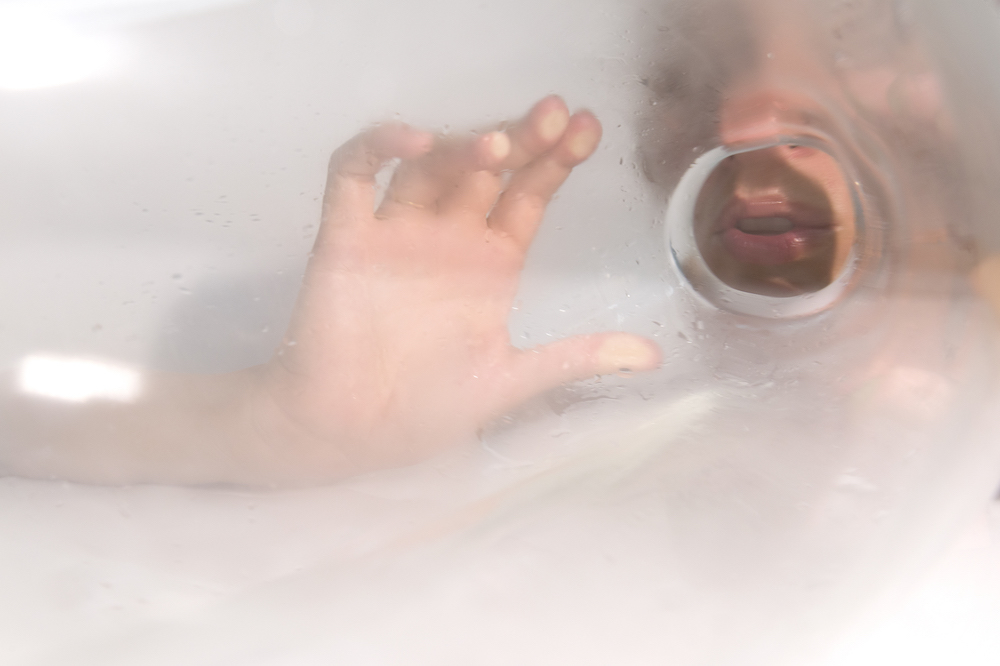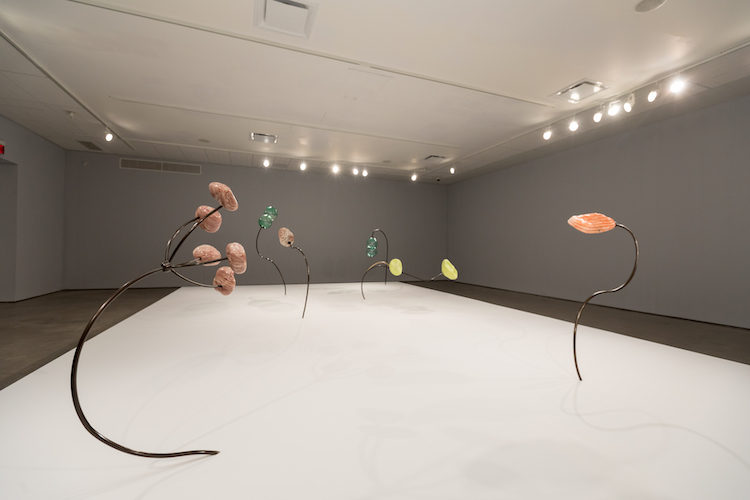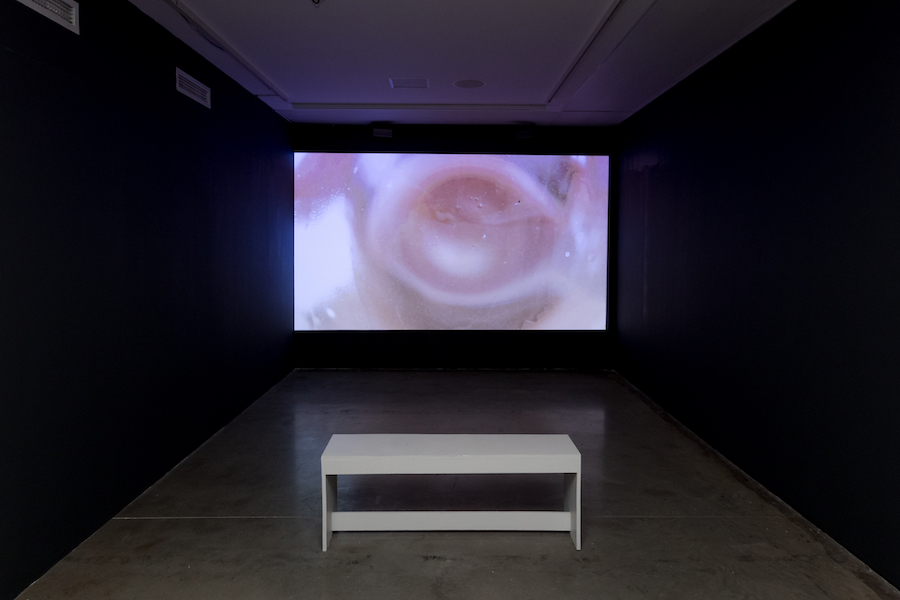A strangeness has taken root in Jennifer Rose Sciarrino’s Ruffled Follicles and a Tangled Tongue, at the Southern Alberta Art Gallery. It’s a strangeness that acts on the body, muddling the senses. I’m not sure if words are strong enough to contain it, as words belong to thoughts, and thoughts belong to heads, and our heads are mostly floating above our bodies. Not in a literal sense, or on an individual basis, but on the scale of systems. The processes of the head – comprehension, deduction, articulation – dominate our ways of knowing and the infrastructures that have coevolved around them. These leave little space for the intelligence of the senses. “It matters which thoughts think thoughts” asserts eco-feminist writer Donna Haraway, to which Sciarrino seems to add: Does it matter which sensations feel feelings?
In Ruffled Follicles and a Tangled Tongue, Sciarrino pushes against Western systems of knowledge, as a lever pivots against a fulcrum. In her first solo museum exhibition, she evinces a long interest in science fiction, speculative futures, and intersectional feminism. Hers is not an effort to abandon technology, language, or scientific models; rather she proposes a shift in alignment by creating works that ask what if? What if we could speak the languages of animals and minerals? What if we could shrink or grow our bodies to be in harmonious proportion with our environment? What if these were the priorities of governments and research dollars? Throughout her practice, Sciarrino has looked to science fiction and speculative futures to uncover bias in our present, while creating allegories for the future. The works in this exhibition continue on this path, but they go one step further, delivering these ruminations in sensorial and uncanny ways.
From Root to Lip (2018) comprises six tentacular figures emerging from, and feeding into, a large, low plinth that spans the majority of its gallery. Ambiguous biota in blown-glass and carved alabaster, held in place by snaking and twisting metal stems. They tower, recline, lunge, and reach, each specimen with its own unique disposition and candor. Like their botanical cousins, these figures’ seductive color and form convey strategies for attracting pollinators, co-conspirators, and symbiotic relations. Though the sculptures are large, their scale is difficult to register. In fact, Sciarrino modeled everything digitally to ensure this specific play of proportions. It’s both unnerving and vertiginous. I feel like Alice talking to the flowers, humbled and bewildered by a reorientation of hierarchy.
This shift in scale calls to mind Donna Haraway’s novel Staying with the Trouble: Making Kin in the Chthulucene, which highlights the hubris of marking an epoch with a human-centred nomenclature – the Anthropocene. Far from an attempt to skirt human responsibility, Haraway’s writing is an appeal to think specifically about our cohabitation on this planet. For Sciarrino’s exhibition, an accompanying essay by Julia Paoli situates the artist’s position within this discussion. She writes: “Ruffled Follicles and a Tangled Tongue’s rehearsal of entanglement embraces a more multi-dimensional and complex understanding of the impact colonial and industrial activities have on natural systems.” So step lightly, Sciarrino suggests, and don’t pick the flowers.
Sciarrino sounds out the reverberations caused by our actions, words, and motives. In Vessels for Coalescence (2018), she strikes an especially vibrating chord. This work consists of a 10-minute video loop, and three torso-sized glass containers. They’re the sort one might expect to see in a laboratory: longnecked with a bulbous cavity. Evidence of past use lightly marks their interiors. In the video portion, three women speak into these vessels, creating a series of echo chambers. Their words are obscured, but the timbre of their voices escapes to bounce loudly around the space of the installation. The echo chamber is a potent symbol, which Sciarrino wields with care. As an archetypal structure of our time, she casts it into a future when human-nonhuman communications teem with new possibility.
The echo is a protective emulsion between the voices and me. The voices – Mutter, Mumble, and Murmur – take solace in their opacity, resisting the quick and tidy reduction of transparency. And so, I wait for comprehension, catching only snippets:
“… I can’t breathe … a recurring dream … dandelion and milkweed …”
Each successive loop reveals a little more, as the connections between my ears and the parts of my brain that make meaning begin to unfurl. In this work, Sciarrino operates at the level of the synaptic, engaging our senses. She reverses a familiar order, asking, what happens if we feel an idea before attempting to comprehend it?
I listen again and again until I am entranced. The effect is similar to mantra, a repetition raising consciousness. I nearly forget to use my eyes. The images move slowly. They’re close-up, fleshy tones, a veil of glass and condensation. Each vessel forms its own sentient accretion – a closed microbial system living in anonymity. Sciarrino works on the body this way, both subtle and persistent.
Ruffled Follicles and a Tangled Tongue plants its nodes in our bodies, not our heads. Through her use of science fiction, speculative future, and intersectional feminism, Sciarrino shares a landscape with a formidable cohort of artists (think: Kapwani Kiwanga’s AFROGALACTICA, Skawennati’s Time Traveller™, Hito Steyerl’s Factory of the Sun) grappling with the ethics of making art out of our current darkness. Navigating bodily between-ness, like vertigo or déjà vu, Sciarrino seeds a niggling thought that sits uneasily. Where the esophagus meets the stomach, this thought resists upward motion toward the spoken. But it resists a downward trajectory, too. We are meant to know this discomfort like a misplaced organ, its rhythms insistent and true.


























